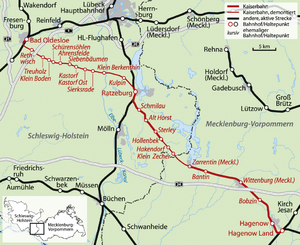Hagenow Land–Bad Oldesloe railway
| Hagenow Land–Bad Oldesloe | ||||||||||||||||||||||||||||||||||||||||||||||||||||||||||||||||||||||||||||||||||||||||||||||||||||||||||||||||||||||||||||||||||||||||||||||||||||||||||||||||||||||||||||||||||||||||||
|---|---|---|---|---|---|---|---|---|---|---|---|---|---|---|---|---|---|---|---|---|---|---|---|---|---|---|---|---|---|---|---|---|---|---|---|---|---|---|---|---|---|---|---|---|---|---|---|---|---|---|---|---|---|---|---|---|---|---|---|---|---|---|---|---|---|---|---|---|---|---|---|---|---|---|---|---|---|---|---|---|---|---|---|---|---|---|---|---|---|---|---|---|---|---|---|---|---|---|---|---|---|---|---|---|---|---|---|---|---|---|---|---|---|---|---|---|---|---|---|---|---|---|---|---|---|---|---|---|---|---|---|---|---|---|---|---|---|---|---|---|---|---|---|---|---|---|---|---|---|---|---|---|---|---|---|---|---|---|---|---|---|---|---|---|---|---|---|---|---|---|---|---|---|---|---|---|---|---|---|---|---|---|---|---|---|---|
| Route number: | 172 | |||||||||||||||||||||||||||||||||||||||||||||||||||||||||||||||||||||||||||||||||||||||||||||||||||||||||||||||||||||||||||||||||||||||||||||||||||||||||||||||||||||||||||||||||||||||||
| Line length: | 78.3 | |||||||||||||||||||||||||||||||||||||||||||||||||||||||||||||||||||||||||||||||||||||||||||||||||||||||||||||||||||||||||||||||||||||||||||||||||||||||||||||||||||||||||||||||||||||||||
| Track gauge: | 1435 | |||||||||||||||||||||||||||||||||||||||||||||||||||||||||||||||||||||||||||||||||||||||||||||||||||||||||||||||||||||||||||||||||||||||||||||||||||||||||||||||||||||||||||||||||||||||||
| States: |
Mecklenburg-Vorpommern Schleswig-Holstein |
|||||||||||||||||||||||||||||||||||||||||||||||||||||||||||||||||||||||||||||||||||||||||||||||||||||||||||||||||||||||||||||||||||||||||||||||||||||||||||||||||||||||||||||||||||||||||
| Operating points and lines | ||||||||||||||||||||||||||||||||||||||||||||||||||||||||||||||||||||||||||||||||||||||||||||||||||||||||||||||||||||||||||||||||||||||||||||||||||||||||||||||||||||||||||||||||||||||||||
|
||||||||||||||||||||||||||||||||||||||||||||||||||||||||||||||||||||||||||||||||||||||||||||||||||||||||||||||||||||||||||||||||||||||||||||||||||||||||||||||||||||||||||||||||||||||||||
The Hagenow Land–Bad Oldesloe railway (also known in German as the Kaiserbahn or Kaiserstrecke—“Emperor Railway”) was a railway line in the states of Mecklenburg-Vorpommern and Schleswig-Holstein. It linked the towns of Hagenow, Ratzeburg and Bad Oldesloe with each other and formed with lines continuing via Bad Segeberg and Neumünster the shortest rail link between Berlin and Kiel, the difference with the other two routes is about 55 kilometres in each case. Today, only the short section between the stations of Hagenow Land and Hagenow Stadt (called just Hagenow until 2010) is regularly served by passenger services, although the Hollenbek–Ratzeburg section is used for draisine rides. The Hagenow–Zarrentin section is served occasionally. The other sections are closed and dismantled. Its alternative name Kaiserbahn refers to Emperor Wilhelm II, who often used it.
Before the construction of the line there were already two rail connections between Berlin and Kiel: the southern route ran via Büchen and Hamburg on the Berlin–Hamburg Railway and the northern route ran via Schwerin–Bad Kleinen and the Lübeck–Bad Kleinen lines. However, both lines diverged greatly from a straight line. At the request of the Emperor, a new route was designed, to run in the area "in between" and bypass the railway hubs of Hamburg and Lübeck. Wilhelm II used the approach that had already been used by Tsar Nicholas I for the Moscow – Saint Petersburg Railway, with a ruler giving the approximate course. The treaty authorising the construction of the railway was finally signed on 5 December 1889.
...
Wikipedia

